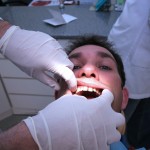
Gingival recession is a common finding and isolated recessions may be treated to improve aesthetics and reduce hypersensitivity. Treatment of multiple recessions can be more challenging and a number of techniques have been proposed. The aim of this review was to assess the effectiveness of periodontal plastic surgery (PPP) in the treatment of multiple gingival recession defects.
Methods
Searches were conducted in the Central, Medline and Embase databases supplemented by hand searching of a number of relevant journals, European Journal of Esthetic Dentistry, International Journal of Periodontics and Restorative Dentistry, Journal of Clinical Periodontology, Journal of Esthetic and Restorative Dentistry, Journal of Periodontology, Quintessence International, American Journal of Esthetic Dentistry.
Randomised controlled trials (RCTs) evaluating surgical treatment of multiple adjacent gingival recession defects in at least 10 patients and with a minimum follow up of 6 months were considered. Two reviewers selected studies and independently assessed study quality. Primary outcomes were complete root coverage (CRC) and percentage of root coverage (PRC). Secondary outcomes were recession reduction (RecRed) and keratinized tissue (KT) gain.
Results
- 9 studies involving a total of 209 patients were included.
- 5 of the studies were split mouth design.
- Follow up ranged for 6-24 months.
- Interventions were very heterogeneous
- CRC after PPP varied from 23.8 to 89.3%.
- No overall information on CRC at patient/site level could be calculated.
- For Miller class I/II recessions (6 studies)
- PRC = 86.27% (95% CI; 80.71–91.83; p < 0.01)
- RecRed showed a WMD of 2.53 mm (95% CI: 2.14–2.91; p < 0.01)
- KT gain = 0.35 mm (95% CI: -0.01 to 0.72; p < 0.06).
- Heterogeneity of the literature prevented inter-techniques comparison.
- Coronally advanced flap (CAF) shows the higher variability in terms of CRC.
- Modified CAF and tunnel approaches show higher level of CRC.
- Network meta-analysis (4 studies) suggests that CAF plus graft showed the higher probability of being the best treatment.
Conclusions
The authors concluded: –
The evidence suggests that different plastic surgical treatments are associated with moderate to high levels of clinical efficacy: all surgical selected techniques were able to produce CRC, and PRC was above 80% on both in Miller class I/II and class III.
Comments
In this review study quality was assessed using an approach based on the Cochrane risk of bias tool and an author derived checklist with 3 of the trials achieving more than 80% with a majority of the trial score in more that 50%. Overall the quality was considered moderate. However, the included trials were relatively small with sample sizes ranging from 10-43 and the review authors highlight a number of methodological and reporting issues with the included studies. The authors also highlight the relatively short follow up period for the majority of the included studies and recommend that ideally 5 year outcomes should be the norm.
Links
Graziani F, Gennai S, Roldán S, Discepoli N, Buti J, Madianos P, Herrera D. Efficacy of periodontal plastic procedures in the treatment of multiple gingival recessions. J Clin Periodontol. 2014 Apr;41 Suppl 15:S63-76. doi: 10.1111/jcpe.12172. Review. PubMed PMID: 24641002.
Dental Elf – 23rd Jun 2015 – Periodontal surgery for localised gingival recessions

Periodontal surgery techniques improved multiple gingival recessions. http://t.co/L06FcjuVR2
Periodontal surgery improved complete root coverage in multiple gingival recessions. http://t.co/L06FcjuVR2
Periodontal surgery improved % root coverage in multiple gingival recessions. http://t.co/L06Fcjdkss
Periodontal surgery techniques improved multiple gingival recessions but evidence limited. http://t.co/L06FcjuVR2
Don’t miss – periodontal surgery for multiple gingival recessions.
http://t.co/L06Fcjdkss
[…] Dental Elf – 2nd Jul 2015 – Periodontal surgery for multiple gingival recessions […]
[…] Periodontal surgery for multiple gingival recessions […]